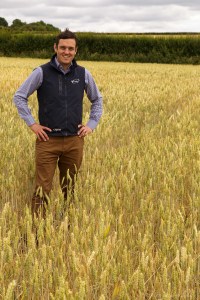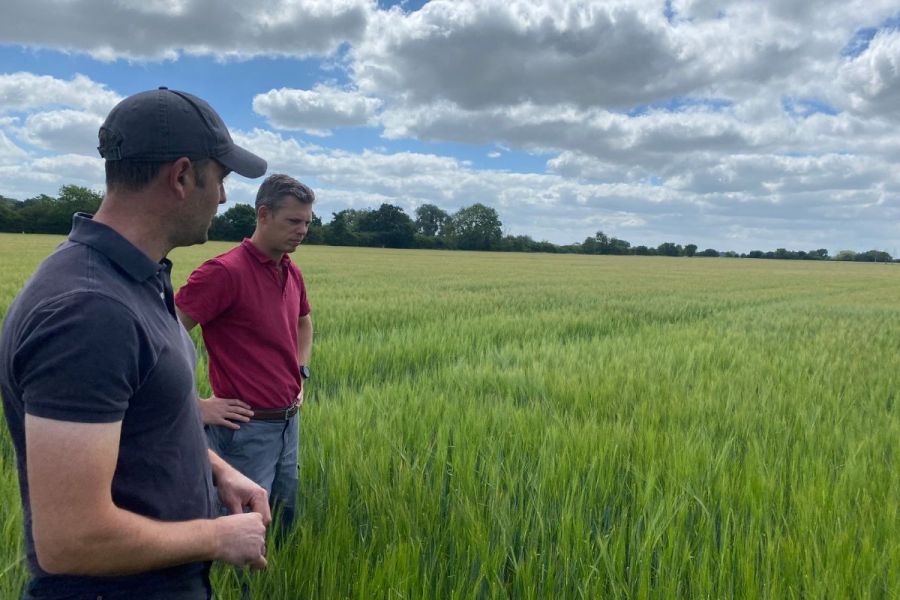Research into a biological seed treatment is suggesting it could both increase yield and potentially help farmers reduce nitrogen requirements. CPM finds out more.
“Growers are still very nervous about cutting back on nitrogen inputs.”
By Mike Abram
Finding ways to cut synthetic nitrogen requirements, or use cheaper alternatives, continues to be a priority for many growers, with imported ammonium nitrate trading at £870/t in September and granular urea at £864/t, according to AHDB.
At those fertiliser prices and a grain price of £260/t for wheat, AHDB’s nitrogen fertiliser adjustment calculator recommends reducing synthetic nitrogen applications by between 25-50kgN/ha, depending on whether the source is ammonium nitrate or granular urea.
With malting barley prices currently in the same ballpark, similar adjustments could be justified for spring barley this spring.
But cutting back further than, or even to, the economic optimum, isn’t the easiest decision for growers given the uncertainty on a field-by-field basis of what that is and the high level of return on investment from fertilisers.

Growers are still very nervous about cutting back on nitrogen inputs and data from trials is really important to help build confidence, says Ed Maule.
“Growers are still very nervous about cutting back on nitrogen inputs,” says independent agronomist Ed Maule from Deben Agronomy.
More data and backing within the industry is required to give growers confidence to reduce nitrogen inputs, he suggests.
It’s one of the reasons why he has been working with microbial nutritional company Biolevel to research whether microbial biofertilisers can be used to reduce fertiliser inputs without any loss of yield.
Biolevel’s GramaxNP product, designed for use in cereal crops, contains microbes that free up essential nitrogen, potassium and phosphorus nutrients within the soil and supplies them to the plant in a form that can be readily taken up, according to the company.
Some of the first trials looking at input reductions in the UK were conducted in spring wheat and spring barley on two farms last spring. Seed treated with GramaxNP at a rate of 2 l/t by a large independent certified seed processor was supplied to the two growers near Woodbridge, Suffolk and Downham Market, Norfolk.
One of the aims was to check that there were no issues with treating seed with GramaxNP, notes Ed. “The processor had no issues – it coated the seed well and was in a stable state when the seed was drilled.”
Three treatments were set up in 12m wide blocks across each field: the non-GramaxNP-treated control with a standard farm nitrogen regime of either 150kgN/ha in the spring wheat or 125kgN/ha in spring barley; the same nitrogen regime with GramaxNP treated seed; and the GramaxNP-treated seed with a 20% reduction in nitrogen.
In the Escape spring wheat trial in Suffolk, that brought the applied nitrogen dose down to 120kgN/ha, while for the Laureate spring barley – also in Woodbridge – and Planet spring barley in Downham Market, nitrogen was reduced to 100kgN/ha.
The bulk of the nitrogen was applied in the seedbed with the remainder topped up at tillering. Each treatment was replicated twice and harvested with a combine with yield monitoring.

The Planet barley with the reduced nitrogen and GramaxNP was level with the standard nitrogen, while all the others had a positive yield response and return on investment even when the nitrogen was reduced, says Tim Eaton.
The results were positive in each of the trials, says Tim Eaton, seed treatment product manager for Certis Belchim, who is marketing the product for Biolevel.
“The Planet barley with the reduced nitrogen and GramaxNP was level with the standard nitrogen, while all the others had a positive yield response and return on investment even when the nitrogen was reduced.”
In the Planet trial, the yield lift was 0.28t/ha from the use of the microbial seed treatment plus regular nitrogen over the farm standard nitrogen alone, while in the Laureate there was a 0.87t/ha increase for the GramaxNP.
“Where the nitrogen was reduced the GramaxNP treatment still did 0.24t/ha more than the standard treatment in the Laureate,” says Tim.
In both trials, a ground cover assessment in early June showed an increase in ground cover of 4-6% where the microbial seed treatment was used over the standard nitrogen, reducing to a 3% advantage even where the applied nitrogen had been cut back by 20%.
“It was a noticeable difference which one of the host farmers picked up on,” says Edward.
Both spring barley crops were grown for seed rather than malting, so grain nitrogen levels haven’t been tested. “It wasn’t the premise of the trial to test for malting quality, but it is obviously something that needs to be looked at.”
In the spring wheat there was a 1.26t/ha uplift in yield from the GramaxNP seed treatment with farm standard nitrogen, and 0.81t/ha increase with reduced nitrogen.
“We weren’t really expecting this result as there hadn’t been much to see visually,” admits Edward.
Field yields in all three cases were average to below average for UK crops last season, especially with the spring wheat, which in the farm standard control plots only yielded 1.94t/ha.
“It was a difficult season for spring crops in East Anglia – it was ever so dry,” adds Tim. “But in my opinion, this could be where these types of products earn their keep. If everything in the crops’ favour, particularly from a nitrogen uptake point of view, then it will be more difficult for the GramaxNP to improve it that much.
“But it is when things are compromised that you need it more – and I think we’ve proven the concept with these trials.”
Ed agrees, drawing on his experience with microbial bionutrition products in other crops, such as potatoes. “You do tend to find is that where there is more of a stressed situation, whether it’s the season or something within the crop, there’s more benefit from using the microbial products.”
In all three trials, there was an increased return from using the Biolevel product, with standard or reduced nitrogen, compared with the farm standard treatment. In each case the highest return came from using the microbial seed treatment with the farm standard nitrogen programme, rather than as a replacement for synthetic nitrogen, with extra yield more than paying for the extra costs of both nitrogen and GramaxNP.
At September 2022 nitrogen prices of £2.50/kgN and grain prices of £258/t for both feed wheat and malting barley, the average increase in return after input costs was £143/ha for the GramaxNP with reduced nitrogen, rising to £194/ha with the farm standard nitrogen programme.
The balance between using GramaxNP as an addition to fertiliser or as a replacement closes where yield responses are smaller. A drop in malting barley price to £200/t using nitrogen bought at the current values would see the difference in return equalise at the yield differences seen in the Planet trial, for example.
The figures do highlight the difficulty in persuading farmers to cut back on nitrogen, highlights Tim. “Even at today’s prices, it’s difficult for them to take the leap, so when nitrogen was much cheaper they were never going to do it. They do need more evidence to help them make the leap, so we’ve got to do more trials to help prove it.”
Further trials are being carried out this season, including in winter-sown crops, says Edward. “We’ve got two winter wheat trials on Gleam, one on moderately heavy land in Essex and one on lighter land in Norfolk, with the same protocol.”
Both are intrigued to see how the microbial seed treatment interacts with a higher yielding autumn-sown crop. “It’s in the ground for a lot longer so will it have more or less of an effect,” says Tim. “Time will tell.”
“Drilling conditions were good,” adds Ed. “So you could say those crops have got off to a very good start, so it will be interesting to see how they fare and what type of season we get.”
Why use as a seed treatment?
Getting the microbial population established in the crop early, theoretically, should be helpful, suggests Ed. “In particular, phosphorus is crucial for establishment, so applying it as a foliar spray to the soil could technically be too late. Putting it on the seed should mean you have the full benefit from the microbes.”
Microbes need the right environment to succeed, such as a seed will, in terms of moisture and temperature so applying on the seed will deliver it to the soil as early as possible for success, he comments.
Biolevel has good data for the use of its products as soil-applied treatments for many crops across the world, adds Tim. “But we needed to prove that those same advantages could be delivered in a cereal seed treatment.”
Formulating the product as a seed treatment requires some particular characteristics, he explains. “It’s all very well having some interesting technical benefits but if the formulation is not user-friendly then it can be prohibitive to both seed processors and growers.
“We were looking for a liquid formulation that is stable and has a lengthy shelf-life in the can, and likewise will be stable and have a reasonable shelf-life once on the seed.”
That will open the market for both the seed processors and growers as it will fit into their usual systems, he notes.
“It also ideally needed to be co-applied with existing complementary fungicidal seed treatments, be easy to apply with no pre-mixing and no refrigerated storage, as most cereal seed processors wouldn’t have that available.’
The seed treatment Biolevel has formulated ticked the boxes Tim was looking for in a product. “We’ve got a very robust product formulation. Shelf-life tests have proven the product can be stored in the can for two years without any problems. Similar tests on the seed suggest the bacterial levels applied remain within the required tolerances for over a year.
“Growers would like to apply a seed treatment that will get an additional return on investment, usually from a yield uplift, not from the crop looking greener the first week after germination or be quicker getting out of the ground,” adds Tim.
And that’s not what the Biolevel product does. “It’s a longer-term thing – the biology goes into the ground, begins to multiply, and over the life of the crop will make more nutrients available to the plant so you get the benefits later on. From the trials, that’s what we’re seeing being delivered.”
Initially Tim thought the value from the treatment, which costs around £13/ha, would come only via additional yield on top of a standard nitrogen programme. “In the early days of these conversations, nitrogen was still cheap, but when nitrogen has gone above £800/t there’s huge value in improving nitrogen use efficiency and being able to reduce the amount applied, both economically and environmentally.”
On-farm trial provides promising result
Oxfordshire grower Peter Bartlett trialled Biolevel’s GramaxNP microbial product last season in a crop of January-sown Skyfall second wheat.
A key priority on the 160ha arable farm in its move towards more sustainable farming is to find alternatives for synthetic nitrogen, because of its impact on the environment.

After trialling GramaxNP on the farm, Peter Bartlett says the results have encouraged him to expand the area treated with Biolevel products to around half the farm this season.
“Gas-fuelled production of synthetic fertiliser accounts for around 1-2% of global greenhouse gas emissions,” he says.
The economics for smaller scale farmers have been tough in recent years, he adds. “So the high price of fertiliser is another factor, although the high prices are somewhat offset by current high commodity prices for wheat and other cereals.
“However, we’ve seen it before – the typical cycle seems to be that you buy fertiliser before the season at a high price, and by the time you sell the grain, the price has dropped.”
That led him to explore the potential of organic microbial biofertilisers to release soil nutrients as an alternative to synthetic nitrogen, setting up a field-scale trial comparing his usual farm practice with a reduced level of nitrogen with GramaxNP and a seaweed product sprayed in early spring.
Both parts of the field had a starter fertiliser of 50kgN/ha with the farm standard then having an additional 55kgN/ha of Nitram applied during spring, while the part treated with Biolevel had no other additional applications.
While it wasn’t a high yielding site on Cotswold brash soil, the final yield from both treatments was similar, according to Peter. “The Biolevel treatment yielded around 95-96% of the normal fertiliser regime.”
Peter was fortunate to buy fertiliser before the huge escalation in price in September 2021 for last season, which meant the savings from the Biolevel treatment, which together with the other inputs cost £80/ha, was only around 15%. “But that would be a lot more now based on current fertiliser prices.”
The results have encouraged him to expand the area he treats with Biolevel products this season to around half the farm. “While the safest way to test products is through university and independent trials, which have proven Biolevel generates better yields, I was happy with the results of our amateurish trial. Coupled with the data Biolevel has, and the way this technology has advanced over the past five years, I’m keen to use it again this season on a larger area.”
Most of his cropping will be spring drilled, so in the majority of cases he prefers to use a seed treatment formulation. “It’s proven to be effective, there’s no risk of the microbes not reaching the seeds, and it offers significant economies in cost and time,” he concludes.
Innovation Insight
CPM would like to thank Biolevel for kindly sponsoring this article and for providing privileged access to staff and material used to help put the article together.
This article was taken from the latest issue of CPM. For more articles like this, subscribe here.




